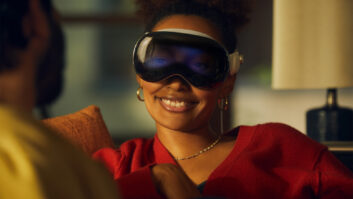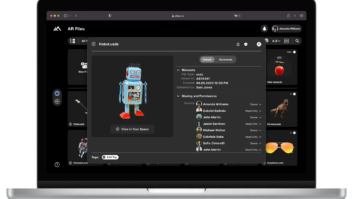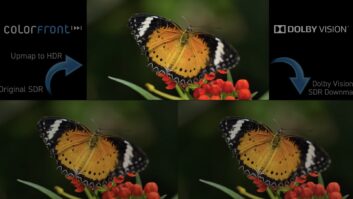The Cameron Pace Group (CPG) wants to demonstrate its technology in Europe covering a football match to prove its vision of simultaneous 2D and 3D production, writes Adrian Pennington. Vince Pace, co-founder and CEO of CPG (left in picture) insists that he and partner James Cameron (on right) share a fundamentally different view to most European 3D broadcasters of how TV coverage can be enhanced.
“I designed our technology with soccer in mind,” Pace told TVB Europe. “I would love to do a soccer game and CPG will get us to that effort. Until CPG gets the tools into their [broadcaster ’s] hands it is hard for us to change prevailing perceptions. It would be great to collaborate with Sky on rugby or soccer and they could get a chance to see those differences.”
Pace was responding to the somewhat sceptical reaction among key European 3D sports producers of Pace and Cameron’s vision (evangelised at NAB) that all TV productions should be able to derive a 3D feed from 2D editorial and camera positions.
Darren Long, Director of Operations at Sky Sports admits to feeling “incredibly surprised by [Cameron’s] comments, bearing in mind how knowledgeable he is about 3D, because I don’t see how you can treat every production the same. It’s true to an extent that some sports can be done in 2D and 3D. But there are certain sports where a normal 2D cut with lots of jumping around will simply not work for the viewer in 3D.”
Sky is trialling dual 2D/3D operation but picking its sports carefully, Long (pictured left) revealed. “Darts works. Boxing is totally possible, snooker also, and other sports where the action is constrained in one area and we’re not swinging cameras around. With football though, you will get away with some joint editorial, but not all. How can a director focus on getting the excitement into 2D and 3D if there is one cut and one set of cameras?”
[For CAN Communicate’s view on the debate see our previous story.]
Pace acknowledges the difference of opinion. “The prevailing view is that 3D is a standalone product which is getting 2D to convert to a 3D methodology, but that is not our direction,” he said. “We recognise that 2D is the revenue stream and we don’t want to be disturbing that. Our view of the broadcast challenge is to concentrate on enhancing the viewing experience without treating 3D as a different product. When people went to see Avatar they enjoyed a good film, which 3D enhanced but wasn’t solely responsible for that enjoyment.”
CPG’s headline grabbing launch at NAB and its declaration that it would target broadcasting were heavyweight messages intended to shake up the 3DTV space, but it’s not as if PACE (his previous company) were not already active in it.
PACE has completed over 40 live 3D sports broadcasts (and several non-sport events), working closely with ESPN, Fox Sports and the NBA and designing and building two dedicated 3D trucks for NEP Visions. PACE recently won a Sports Emmy Award with CBS Sports the 2D/3D production of the 2010 US Open Tennis Championship.
“Although I think the direction is fundamentally different for us we’re not just the Hollywood guys shouting at broadcast with loudhailers,” said Pace. “We have learnt from working with ESPN and we continue to learn. Our approach to designing technology is to use as many of the 2D assets as we can, to tell the story of sports with a 2D foundation and elevate the viewing experience to another level.”
For Pace the best way of telling the story of a live sports game has already been devised by 2D producers, so why change the wheel?
“I used to say, like many others, that 3D is the best seat in the house. But I now realise that the person sitting in the best seat in the house is the 2D camera guy and the 2D director. That’s how it has been planned so we have to find ways of working with that, not against it.
“Another example – there is a lot of value in the colour and commentary of a 2D sportscast with which people are familiar. Are we going to have to condition people to accept separate commentaries?”
The experience of the Sony/HBS production of the FIFA World Cup and also of Sky Sports’ 3D coverage of English Premiership Football leans toward a slower pace of cuts, judicious use of Steadicams at pitchside, slower pans and a belief that the Camera One gantry position doesn’t provide the depth of field to add anything for the 3D viewer. Sky is negotiating with English soccer stadia to locate its rigs on lower positions.
This editorial philosophy is at odds with that of CPG, and Pace recognises that he has a fight on his hands to convince broadcasters to alter their perceptions.
“The technology feels like it is restricting the editorial vision at this point – that you can’t move cameras fast, that you have to frame differently in 3D, that the high up angle is flat,” he said. “When you are dealing with tools at a basic level it pushes you into an interpretation of 3D that is unfair. This is what happens when you don’t have the right tools to experiment with. The technology should be working with the subject matter, not against it.”
Pace points to the Shadow system (a combination of rig and software) which was used by CBS Sports to produce 2D and 3D coverage of the US Masters golf tournament in April as an asset CPG believes can be used to deliver 2D and 3D shared technical and editorial operations.
The Shadow D rig stacks a 3D camera next to a longer 2D camera lens and allows one camera operator to control and drive both cameras with one set of controls, capturing 2D and 3D images simultaneously. This allows 2D camera operators to capture 3D without learning new production techniques, reduces 3D production costs and says Pace, solves the conflict of 2D and 3D camera placement around a sports venue.
“The key is camera balance,” says Pace. “If you have continuity in stereo you will have continuity in 3D storytelling so that when cutting between 8 or18 cameras you are aware of how all the cameras complement each other.
“With Shadow Vision I can read a distance to a subject, read focal length and adjust my framing based on that information. I can either take the 2D shot or I can decide to adjust my shot for 3D by keyframing the difference between the 2D and 3D frame.”
In practice Pace says he finds that often the standard 2D shot is the optimal one for 3D.
“On tennis for example we initially decided to be close up on the player’s face for 2D because 2D likes reaction shots, and we keyframed for a wider shot on the player for 3D. But after a while we decided to match 2D exactly and it worked perfectly. The reason was that 2D was going for the reaction shots, which is critical to a viewer’s understanding of the flow of the game regardless of the format you are watching in.”
There is, in fact, a great deal of common ground between Cameron – Pace and, say, the BSkyB position, not least in the drive to reduce operational costs by using technology to streamline production and eradicate the number of convergence and 3D technicians as far as possible.
“I had six cameras on the US Masters event with one person supervising camera performance and overall creativity – no operators. You can divest yourself of the expense of travel, hotel, salary and food costs for additional and unnecessary crew today,” said Pace.
“The problem is that we are all discussing the 10-30% difference between 2D and 3D when we should be working on the 60% that is positive and the same. I think the viewer wants an enhanced viewing experience, yet we get so caught up on how this camera pan won’t work, or this cut won’t make it in 3D – shots which wind up being 5% of the total show. As an industry we are fixated on that 5% instead of the real heart of the production. If we can elevate 2D production into an entertainment experience people are willing to pay for then we will have accomplished our goal.”





